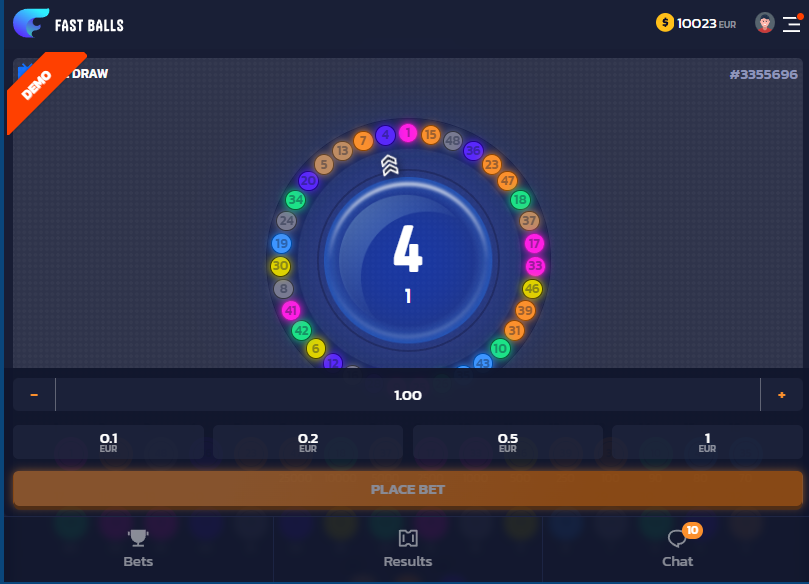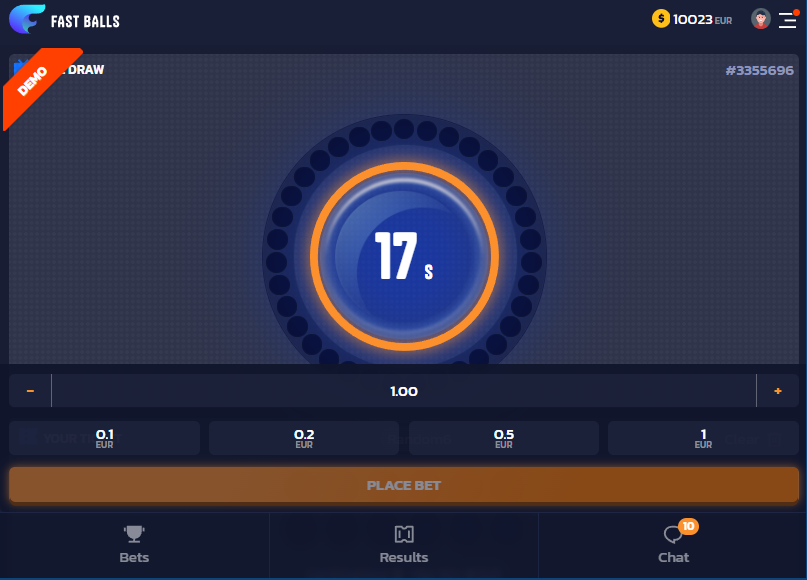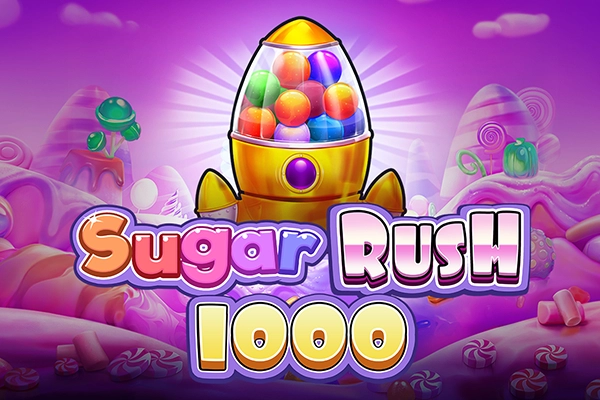Fast Balls by Elbet presents a high-speed lottery-style experience, diverging from conventional slot formats. The game features a minimalist digital atmosphere, prioritizing functional design and numerical probability over any narrative elements. Its layout is a clean interface with a central drawing mechanism and 48 number positions. The core gameplay challenges players to match a six-number combination from the 35 balls drawn each round. Crucially, payouts are dictated not just by the match, but by the exact position in which the final, sixth number is drawn. This unique mechanic creates intense, front-loaded volatility, concentrating the highest rewards in the initial draws. Fast Balls operates with an exceptionally high theoretical RTP of 99.35%. An occasional, randomly triggered Bonus Game doubles all winnings, adding another layer to the game’s statistical framework.
Elbet's Fast Balls presents a departure from the conventional reel-and-symbol structure of most online games. It positions itself squarely in the category of rapid-draw, lottery-style entertainment, a field where Elbet has established a significant presence. This game sidesteps narrative themes and elaborate graphics in favor of a purely mechanical and statistical player experience. The central premise is not merely about matching numbers, but about the velocity at which those matches occur. Success is measured in fractions of a minute, with a payout structure that heavily rewards early completion. This analysis will deconstruct the game’s core mechanics, its notable payout system, the mathematical implications of its features, and the minimalist aesthetic that defines its gameplay loop. It is a game built on probability and speed, designed for an audience that appreciates the purity of a numbers game over thematic immersion.

The Core Payout Mechanism: A Matter of Position
The entire financial architecture of Fast Balls is built upon a single, critical concept: the position of the final matching ball. The game draws 35 numbers from a pool of 48 in each round. The player selects a set of numbers, and the objective is to have a six-number combination from that set drawn as early as possible. The paytable does not reward you for matching three, four, or five numbers; it only activates when a full set of six is completed. The multiplier you receive is inversely proportional to the time it takes to achieve this.
This creates an environment of intense, front-loaded volatility. For instance, if your chosen six numbers are among the first six balls drawn from the machine, the payout is a substantial 25,000 times the stake per combination. If your sixth and final number is matched on the 10th ball drawn, the multiplier dramatically drops to 1,000x. By the 20th position, it is down to 40x, and should your sixth number appear on the 35th and final ball, the payout is a mere 1x, simply returning your stake for that combination. This structure means the first 10 to 15 draws of the 35-ball sequence are where the vast majority of the game's significant winning potential is concentrated. After that point, the returns diminish to a level that primarily serves to mitigate losses rather than generate substantial wins.
The game allows the selection of six to twelve numbers. Choosing only six numbers constitutes a single bet on one specific combination. However, selecting more than six numbers—for example, choosing seven numbers—automatically creates every possible six-number combination within that set. With seven chosen numbers, you are effectively placing 7 individual bets. If you select the maximum of 12 numbers, you are wagering on 924 distinct six-number combinations simultaneously. This is a critical strategic consideration. While increasing the number of selections broadens your coverage and increases the probability of hitting a combination, it also multiplies the total stake by the number of combinations generated. The final win is calculated by the formula: Winning Amount = Combination Multiplier x Stake Per Combination. This means a win is applied only to the specific six-number combination that was completed, not the entire wager.
Bonus Feature and RTP Implications
Beyond the standard draw, Fast Balls incorporates a randomly occurring event known as the “Bonus Game.” When a round is designated as a Bonus Game before the draw begins, any winnings produced during that round are doubled. This feature is elegantly simple, requiring no player input or change in strategy. It functions as a direct, flat multiplier on the established paytable. A win at the 6th position, normally 25,000x, would become 50,000x during a Bonus Game, subject to the game's overall maximum payout cap.
This bonus mechanic is not merely a decorative addition; it is a mathematically integral component of the game’s return profile. The stated Return to Player (RTP) is an exceptionally high 99.35%. Elbet provides a transparent breakdown of this figure: 95.55% of the RTP is derived from the base game's paytable, while the remaining 3.80% is attributed directly to the value provided by the Bonus Game feature. For the analytical player, this information is highly valuable. It confirms that the base game operates with a strong return rate on its own, but also that a significant portion of the long-term statistical return is concentrated in these periodic, high-value bonus rounds. It underscores the feature's importance beyond being a simple jackpot event, framing it as a core part of the game's economic model.
Gameplay Dynamics and Strategic Considerations
Player interaction in Fast Balls is concise and focused, centered entirely on pre-draw decisions. The primary strategic choice lies in the number of selections made, ranging from 6 to 12. This decision represents a direct trade-off between risk concentration and coverage. A player opting for a 6-number selection places a highly concentrated, single bet with a lower initial cost. This approach requires precision but offers a straightforward risk-to-reward calculation. Conversely, a player selecting 12 numbers is casting a wide net, covering 924 different combinations. This drastically increases the probability of completing one of those combinations but also inflates the total cost of the wager 924-fold compared to a single-combination bet of the same stake.
The gameplay loop is engineered for speed. The user interface prominently features a countdown timer, signaling the short interval between rounds. This design encourages rapid, successive play sessions, distinguishing it from more contemplative, slower-paced table games or feature-heavy slots. The mechanics are transparent, with the drawn numbers clearly populating the circular display, allowing for an immediate cross-reference against the player's chosen numbers. The complexity of the combination betting system might initially appear daunting. Should the combination betting system feel abstract, launching the demo Fast Balls version and accessing the built-in help file (usually marked with an “i”) provides a comprehensive breakdown of how selecting more than six numbers translates into multiple wagers.
A crucial element that affects high-stakes play is the maximum payout cap of 10,000 EUR per bet. This cap can come into play even for moderate bettors who achieve a top-tier win. For example, a wager with a 1 EUR stake per combination that successfully completes at the 6th position (25,000x multiplier) would theoretically yield 25,000 EUR. However, the payout would be capped at 10,000 EUR. Players should be aware that any combination of stake and multiplier that exceeds this ceiling will be limited. This positions the game less as a vehicle for a single, life-altering jackpot and more as a system for achieving high, yet bounded, returns.
Visual Presentation and User Interface
The aesthetic of Fast Balls is one of clinical efficiency and digital minimalism. It forgoes any attempt at narrative or character-driven design. The color palette is dominated by deep blues and dark grays, creating a high-contrast backdrop for the critical game elements, which are highlighted with luminous blue and orange accents. The central focus of the screen is a large, circular orb that serves as the main information hub, displaying the countdown timer before the draw and the primary drawn number during the sequence.
Animation is functional rather than ornamental. As numbers are drawn, they appear in the center before populating a ring of 48 smaller circles, with matched numbers being clearly color-coded for instant recognition. This visual feedback loop is immediate and unambiguous, ensuring the player can track the game's progress without any cognitive friction. The interface for placing bets is equally streamlined, with predefined stake values and a simple plus/minus adjuster. There are no extraneous visual elements to distract from the core mechanical process. The developer notes that the game includes “beautiful background music and sound effects,” intended to complement the rapid pace. This sound design is an optional layer, easily toggled, but its inclusion suggests an attempt to create a more engaging sensory experience within the minimalist framework.

Elbet has integrated several features that enhance the overall user experience and add a layer of community. The most notable of these is the in-game chat function. This transforms what is typically a solitary activity into a shared social space. Players can comment on outcomes, share winning bet slips, and interact with others who are participating in the same draws. This feature is more commonly associated with live dealer games and its presence here is a clear effort to foster a sense of community around the rapid-fire draws. It is a well-considered addition that provides value beyond the core game mechanics.
The game also includes standard but essential quality-of-life tools, such as a “My Bets” history for reviewing recent wagers and a disconnection policy that ensures bets are honored and winnings are paid if a player's connection is interrupted mid-game. These operational safeguards, along with the clearly stated error-handling protocols, contribute to a sense of reliability and trustworthiness. While Fast Balls is fundamentally a game of chance built on a rigid mathematical model, these supporting features demonstrate a thoughtful approach to the player’s comfort and confidence in the platform. The combination of its high-speed nature, transparent mechanics, and communal chat feature makes it a compelling option for players seeking a direct and fast-paced form of number-based gaming.













